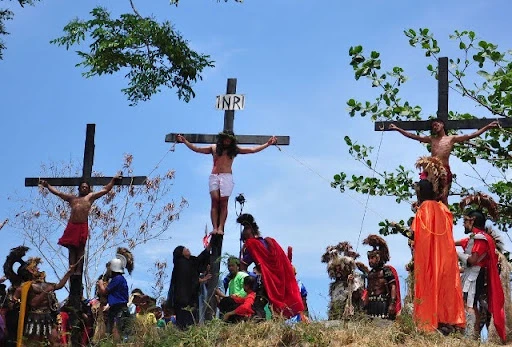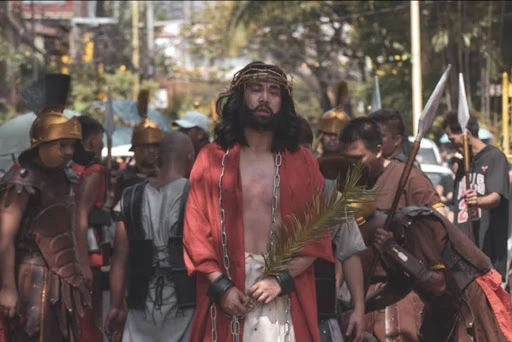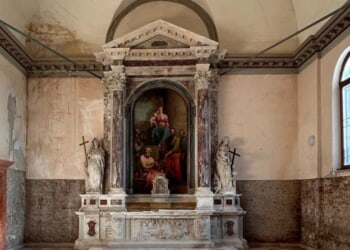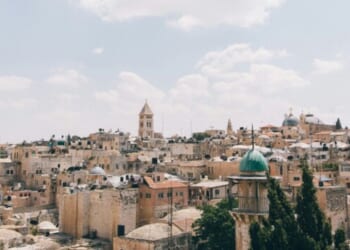
Manila, Philippines, Apr 18, 2025 / 08:00 am (CNA).
Every Holy Week, streets across the Philippines transform into open-air stages for one of the country’s most unique and deeply rooted Catholic traditions: the “Senákulo,” a dramatic reenactment of the passion, death, and resurrection of Jesus Christ.
This age-old practice is not just theater but an opportunity to evangelize people right where they are — on the streets. Families, parishes, and entire “barangays” spend weeks preparing for the street plays, which have become a powerful expression of Filipino faith and cultural identity.
“The Senákulo is more than a performance,” said Brother Elmer Reyes, a longtime director and scriptwriter of Holy Week plays in Bulacan. “It’s a way of catechizing the people. It’s how many come to know the Gospel — not just in their heads but in their hearts.”

Rooted in the Spanish colonial period, the word “Senákulo” comes from the Spanish “cenáculo,” meaning “upper room” — the place where Jesus and his disciples shared the Last Supper before his crucifixion. The tradition has evolved through the centuries, but its purpose remains the same: to bring the story of Jesus’ sacrifice to life, allowing people of all ages to encounter the mystery of the cross in a vivid, unforgettable way.
The cast is made up of volunteers, many of whom return year after year to take on roles that have become part of their personal faith journey. For many young people, participating in the “Senákulo” has kept them off drugs and gangs.
“I’ve been playing Mary Magdalene for 12 years,” shared 29-year-old Jessa from Pampanga. “Each year, it humbles me. It makes me cry. Because in her, I see my own conversion story.”
“There were moments of doubt, overthinking, and even wanting to give up as I prepared for the role — but the will of God is greater than mine,” shared James Harold Gaffud, who portrayed Jesus in the city of Echague, Isabela. “It brings me sorrow and anguish to reenact the Passion, but it’s an opportunity to express our utmost love and sacrifice, and to commemorate the passion, life, and death of Our Lord. During the Stations, I knew it wasn’t me — it was God’s spirit moving through me, helping me act naturally and express the emotions beautifully.”
For others, playing Jesus becomes a form of penance and personal offering.
“Jesus is everyone’s hero,” said Mark Akino, who portrays Jesus and serves as assistant director in a Senákulo in Makati City. “There’s a joy and blessing I feel after every performance. I really feel every lash and the weight of the cross. None of us are perfect — we all sin in different ways. But for me, this is one way to make up for my sins and say thank you to God for the gift of life.”

In San Fernando, Pampanga — dubbed the “Lenten Capital of the Philippines” — reenactments go much further. Some devotees allow themselves to be literally nailed to wooden crosses in front of thousands of spectators. An estimated 30,000 visitors gather to witness the “Passion of Christ” street plays held in the city every Good Friday.
One of the most well-known devotees is 64-year-old Ruben Enaje, a construction worker who has been nailed to a cross 35 times since the first time in 1986. A day prior, he goes around town carrying a life-sized cross to do the Stations of the Cross with his community. He began this tradition after surviving a near-fatal fall from a building, believing that God had spared his life for a reason. Determined to honor this second chance, he made a promise to reenact the suffering of Christ every Good Friday.
“I told myself, if I survive, I will let myself be crucified for God. That will be my thanksgiving,” Enaje told a local news outlet.

For many communities, the Senákulo is also a moment of unity and reconciliation. Months of rehearsals foster camaraderie, healing of past wounds, and a shared sense of mission. Youth, elders, and entire families bond over sewing costumes, preparing props, and praying together before every show.
“This is our ‘panata’ [personal vow to God],” said Mang Andres, a 55-year-old carpenter who has built the cross used in his town’s Good Friday scene for over three decades. “As long as I live, I will keep doing this for Jesus.”
For the audience, many of whom line the streets barefoot or holding candles, the experience is powerful and emotionally stirring. The Senákulo has a way of reaching even those who may rarely go to Mass, bringing the love and sacrifice of Jesus right where they are — on the streets.
These physical reenactments are considered “penitensya” (penance) or a panata in the Philippines. Many do it barefoot under the scorching sun, wearing crowns of thorns, whipping their own backs with bamboo lashes until they bleed — reenacting Christ’s suffering in an intensely personal way, to ask forgiveness for sins or in gratitude for miracles received. They say they do this to fulfill their “personal vow” to God. While the Catholic Church does not officially endorse these extreme acts, it acknowledges the personal expression of faith behind them.

The Catholic Bishops’ Conference of the Philippines (CBCP) encourages the faithful to see the Senákulo as a complement to the liturgy, not a replacement for it. Priests remind communities to participate in the paschal Triduum — Holy Thursday, Good Friday, and the Easter Vigil — even as they take part in street plays and devotions.
The faithful are also reminded of other ways to commemorate Christ’s sacrifice during Holy Week, especially through the Stations of the Cross, fasting and abstinence, receiving the sacrament of confession, or “Visita Iglesia,” a Filipino tradition of visiting seven churches on Good Friday while doing the Stations of the Cross.
The Senákulo has been around since 1947 and remains an effective tool of evangelization — especially when it is Christ-centered and leads people to a deeper conversion. While the life story of Jesus is often read or heard within church walls or classrooms, the Senákulo brings his story to life in the public square.
“It’s not just a play,” said 26-year old Paula, who watches every year. “It’s the Gospel — and it’s alive, right here on our streets.”
If you value the news and views Catholic World Report provides, please consider donating to support our efforts. Your contribution will help us continue to make CWR available to all readers worldwide for free, without a subscription. Thank you for your generosity!
Click here for more information on donating to CWR. Click here to sign up for our newsletter.









